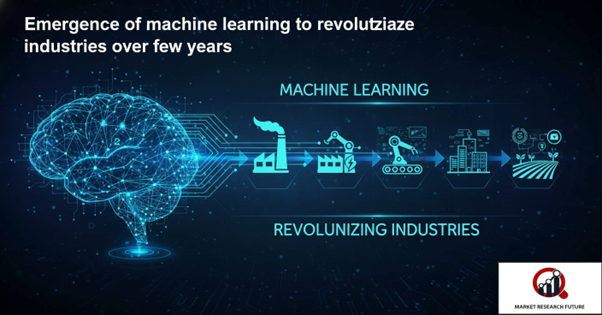Emergence of machine learning to revolutionize industries over few years

The Introduction to the Machine Learning Market
The enhancement of the consumer experience has been a new mission for organizations, which is driving the global machine learning market at a massive CAGR of 32.8% through the forecast period. The valuation of the ecosystem will likely change from USD 5.6 billion in 2024 to USD 116.7 billion by 2035
Machine learning-based products, such as Netflix's recommendation engine and self-driving cars, have become possible in recent years due to advancements in storage and processing capabilities.
Machine learning is a key component of the rapidly expanding field of data science. Algorithms are trained using statistical techniques to produce classifications, predictions, and to uncover meaningful insights in data mining projects.
The decisions derived from these insights influence key growth indicators in applications and enterprises. As big data continues to grow, data scientists are increasingly in demand to identify the most pertinent business questions and the data required to address them.
The goal of automation in machine learning is to reduce the manual labor needed to build and deploy models. Automated machine learning (AutoML) platforms are becoming more widespread, enabling non-experts to leverage machine learning capabilities and accelerate model creation.
Deep learning, a subset of machine learning using multi-layer neural networks, is also improving rapidly. The availability of large datasets, coupled with increased processing power and algorithmic efficiency, has propelled deep learning advancements in computer vision, natural language processing, and speech recognition.
Effects of Technological Breakthroughs on Machine Learning
Recent innovations in neural network architecture, training methods, GPU performance, and data accessibility have fueled deep learning’s growth. The rise of robotics, IoT, cybersecurity applications, industrial automation, and machine vision has generated vast amounts of data.
These datasets serve as training material for deep learning algorithms, assisting in diagnostics, testing, and predictive tasks. Machine learning has unlocked applications across industries. Advertising leverages it to target audiences and predict consumer behavior, while AI-driven marketing models automate and optimize decision-making.
In banking and finance, machine learning supports asset management and loan approval. Other sectors benefiting include document management, security, healthcare, and publishing.
Deep learning algorithms excel at repetitive tasks and can provide critical insights while ensuring quality. Organizations adopting these technologies save time and resources, allowing human staff to focus on creative, high-value work. Consequently, deep learning is considered a disruptive technology, driving demand across multiple end-use sectors.
Market Behavior
In healthcare, machine learning is transforming diagnostics. For instance, Google DeepMind has developed an algorithm capable of detecting retinal conditions like diabetic retinopathy.
Machine learning enables early detection, faster treatment, and reduced workloads for medical professionals. Additionally, it supports drug development, personalized medicine, and disease outbreak forecasting.
Many industries now depend heavily on machine learning (ML). However, developing high-performance ML systems requires highly specialized data scientists and domain experts.
AutoML reduces this dependence by enabling domain specialists to create machine learning applications without extensive statistical expertise. With the rise of subscription-based and pay-as-you-go AutoML solutions, adoption is expected to increase globally.
The COVID-19 pandemic has further accelerated the adoption of AI-driven intelligent solutions to automate business processes, boosting demand for machine learning across sectors.
Regional Analysis
The machine learning market demonstrates strong growth across global regions. North America remains the largest market, driven by widespread adoption of AI, advanced cloud infrastructure, and the presence of leading tech companies in the US and Canada.
Europe follows closely, with Germany, the UK, and France investing heavily in AI research, automation, and industrial applications. Asia-Pacific is witnessing rapid expansion, led by China, India, Japan, and South Korea, fueled by large-scale data generation, smart manufacturing initiatives, and government-backed AI programs.
Emerging markets in Latin America and the Middle East and Africa are gradually adopting machine learning solutions in sectors such as healthcare, banking, and logistics, with strategic investments from multinational corporations driving regional growth.

Leave a Comment